Table of Contents
- 1 Collecting Content from the Internet With Papyrus Author
- 2 The Navigator Research Tab – an Overview of Your Research
- 3 Research Settings (Copying, Citation Format, etc.)
- 4 “My Research” Fields
- 5 Generating a List of Citations for Your Bibliography
- 6 The Interaction of Papyrus Author and Internet Browsers (Papyrus Research Add-On)
- 7 Deleting Research for a Document
Look for inspiration and ideas on the Internet, research with Wikipedia, and just drag everything useful that you find into the document window or the Navigator of Papyrus Author.
Collecting Content from the Internet With Papyrus Author
Use your mouse ![]() to drag content–text or pictures–from your browser into your Papyrus Author document. You can drag text or pictures into the Navigator outline view, the research tab at the bottom of the Navigator or even into your main text.
to drag content–text or pictures–from your browser into your Papyrus Author document. You can drag text or pictures into the Navigator outline view, the research tab at the bottom of the Navigator or even into your main text.
Papyrus Author will then ask you (the first time you bring in research) whether you would like to have the background information about your research saved.
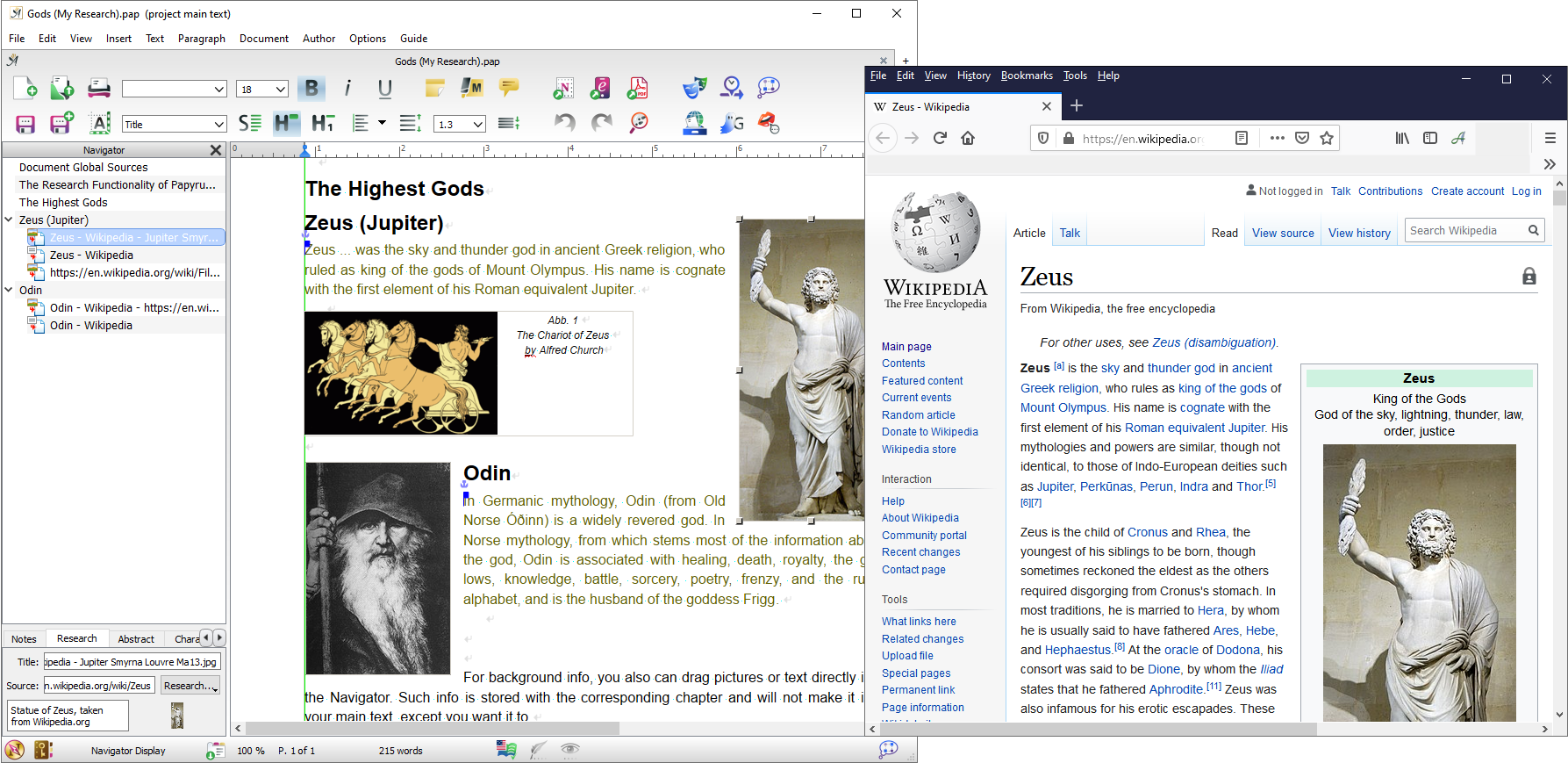
A picture from the internet can be dragged into your Papyrus Author document with your mouse and background data will be stored automatically
If you want to store info about your research ( ![]() ), a research entry will be automatically created for you in the Navigator. All of the available sources and background information will be saved: name of the Web page, the internet address (URL), a large field for the content of your research as text, a description or a picture, if you have chosen one.
), a research entry will be automatically created for you in the Navigator. All of the available sources and background information will be saved: name of the Web page, the internet address (URL), a large field for the content of your research as text, a description or a picture, if you have chosen one.
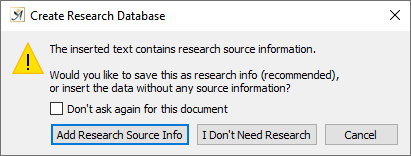
When you insert a file from the internet, Papyrus Author asks if you would like to save research info
Which data will be saved when you drag and drop ![]() or copy and paste varies from browser to browser.
or copy and paste varies from browser to browser.
You are free, of course, to edit the research information as well as add to it.
Methods to Store Your Research
You can choose to save pictures and text only in the Navigator (as background information that can only be seen by the author). This is what we call a “source.” Simply drag a picture ![]() or text
or text ![]()
![]() directly into the Navigator–either into the global “sources” (found at the very top of the Navigator) or into the appropriate chapter in the Navigator outline view.
directly into the Navigator–either into the global “sources” (found at the very top of the Navigator) or into the appropriate chapter in the Navigator outline view.
You can also pull the content of your research directly ![]() into your main text–which is what we call a “citation” (
into your main text–which is what we call a “citation” ( ![]() text or
text or ![]() picture).
picture).
If you want to have the entire source in your main text, you can simply pull the research entry from the Navigator into your main text ![]() . All of the text you see in the research tab will then be found in the main document. If it is a picture, it will be inserted into the main text.
. All of the text you see in the research tab will then be found in the main document. If it is a picture, it will be inserted into the main text.
You can also bring the entire contents of the text field, or just a part of it, into your main text ![]() by using the “Research” button located in the research tab.
by using the “Research” button located in the research tab.
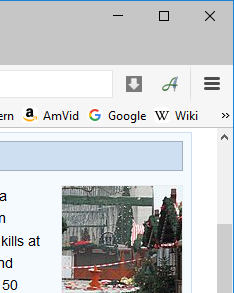
The Papyrus Author icon represents the research add-on in your browser
Pictures can also be dragged as a “citation” from the preview in the Navigator research tab into ![]() the main text.
the main text.
Of course, you can also store your research in the Navigator first and then copy it into the text later (a “source” entry would then become a “citation”).
Another possibility is to use the button available as a browser add-on for Firefox and Google Chrome to save your research in Papyrus Author.
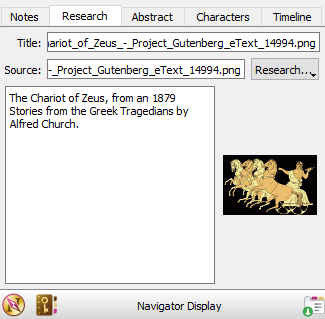
The Navigator Research tab with a small view of the research data
In the “Research” tab in the bottom of the Navigator you can find a summary of the research you have collected in Papyrus Author so far.
The dialog changes its size depending on whether you only have a bit of text or need to leave room for a picture.
The research tab in the Navigator is a smaller, easy-to-access version of the entry forms in the research database.
Thus, it’s not necessary to spend too much time and energy on the research database, especially if you are not planning to manually add a lot of research to it. You can give your text your full attention–the database simply works in the background.
In the popup ![]() you will find the controls for the research database:
you will find the controls for the research database:
You can manually create a new research entry by clicking on “New research,” if you don’t want to drag and drop from your browser.
Existing entries can also be opened in your browser here. Or you can open a research entry in the research database belonging to it.
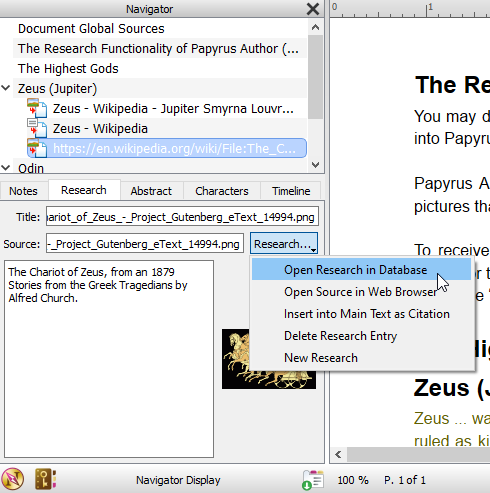
The options in the Research tab in the Navigator
In the description field, you can mark the text of a source and paste it into your main document.
Pictures you have pulled from the internet (or another source) will be saved in the text and in the database. You can find them in the “My Research” folder for your document.
Papyrus Author can tell that a picture is a “citation” from its reference in the picture catalog (A visual list of all the pictures in your document can be found in the menu “Graphics” → “Picture Catalog”). If you only take a part of a picture from the picture catalog, the research information will still be attached to it.
In the research tab you can “overwrite” an old picture with a new one, by dragging and dropping it into the mini version of the old picture. When you do this, only the new picture will be stored, not any new research information.
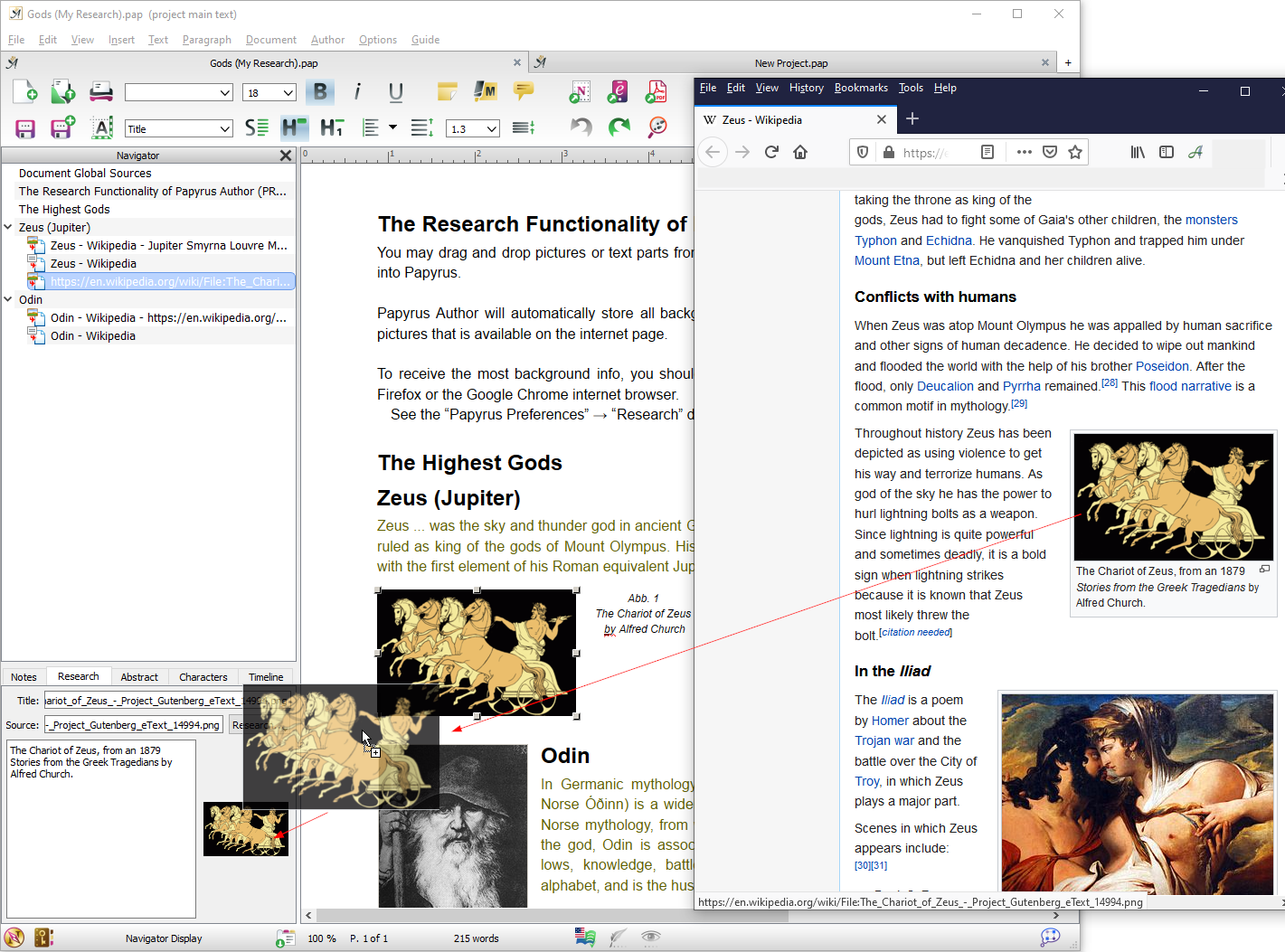
Dropping a picture onto an old one in the Research tab will cause the picture to be overwritten with the new one but the research info will not change
Be careful to cite your picture sources correctly. Papyrus Author assumes that you want to keep the original bibliographic information and only want to for example exchange the picture for a larger one in better quality (as is often the case for Wikipedia pictures).
The picture will then also be updated in the research database. If, however, you change the picture in your database, the picture in your text will not be updated.
Move or copy sources or citations within the Navigator by using your mouse ![]() . You can also pull your research directly from the Navigator into your main text.
. You can also pull your research directly from the Navigator into your main text.
When you make a copy of your research, Papyrus Author will not make another copy in the “My Research” database. Both copies in the Navigator will refer back to the same entry in your database, which avoids having multiple copies of the same information.
These same principles apply regardless of whether you are working with a “source” (only in the Navigator) or a “citation” (also used in the main text).
Especially when you want to copy a picture source or a picture citation, it is better if the picture only is saved once, instead of making multiple copies.
Thus, you can make a copy of a picture “citation” or use a portion of the picture available in the picture catalog. By using the picture copy in the main text, a research entry will be created automatically in the Navigator for the new spot in the text.
It’s also possible to copy research into other documents. You can copy a picture or text from either the main text or the Navigator.
Copies from other documents can be pasted either into the Navigator or the main text. By doing so, an entry in the “My Research” database of the new document will be created.
Research Settings (Copying, Citation Format, etc.)
The “Research” settings can be accessed in the Papyrus Author “Preferences” under “Appearance” → “Research.”
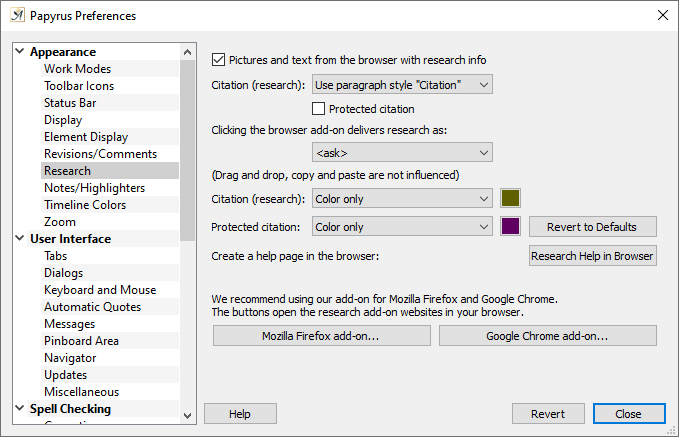
The Research settings
In this dialog you can decide whether research you copy from the internet should be copied with or without research information such as citation, sources, etc.
“Citation (research)” decides how text you have copied from a browser will be inserted into your Papyrus Author document.
The first question is whether your citation should get its own paragraph or not. If you would like it to, you can choose the option “Use paragraph style ‘citation’.” The paragraph will then be formatted with the “citation” style template, which you can edit as you like. You can also choose to insert the text in a paragraph with or without quotation marks.
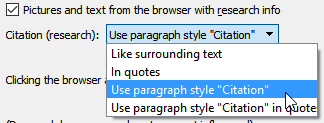
You can decide how your citation should appear in the text
If you do not want your citation to have its own paragraph, but would prefer that it simply appears within your own text, you can choose the option “Like surrounding text.”
You can add research either by dragging and dropping into Papyrus Author, or by using the button in the browser add-ons. Here you can decide how research should be inserted into your text.
Citations and protected citations can be given a special color so that they are more visible in your text.
The button “Research Help in Browser” is meant to help you prepare your browser for proper data collection.
We recommend that you use Firefox or Google Chrome as your browser and install the Papyrus Author add-on to make adding research to your document smoother and easier (see below for further information).
“My Research” Fields
The background information for all data collected from the internet is saved in the “My Research” database with forms that have different fields.
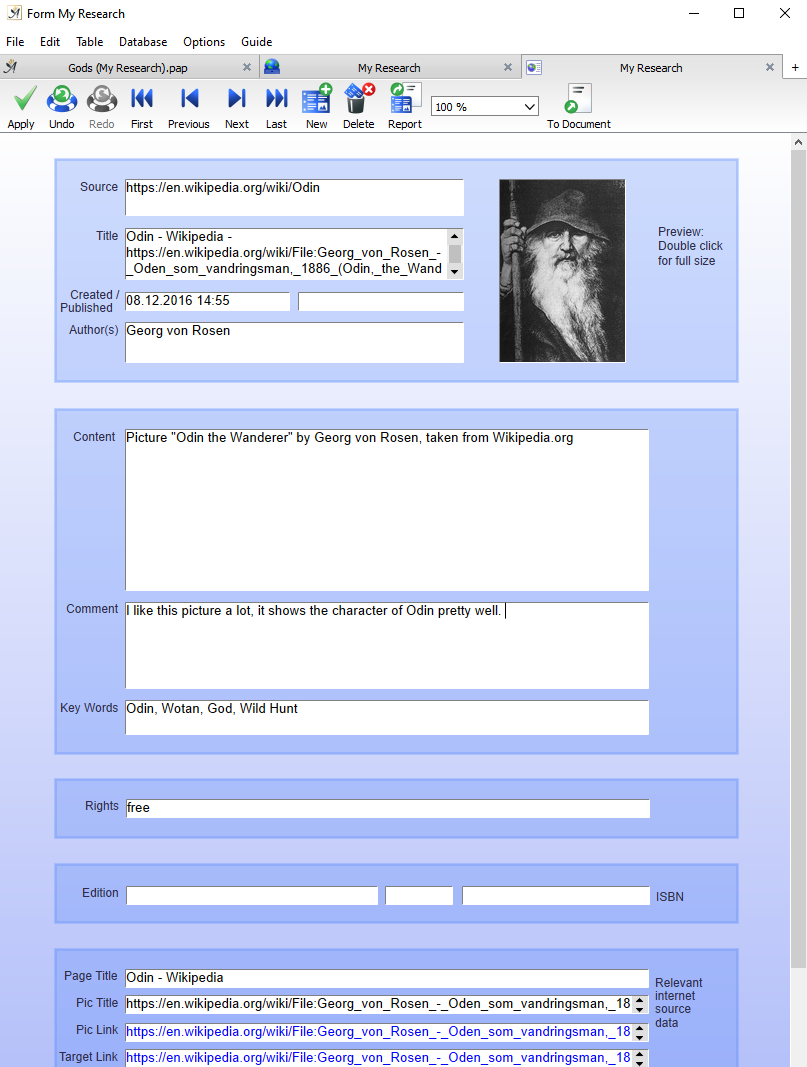
A record of a stored research file with background information
The fields “Title,” “Source,” and “Content/Description” will always contain the same information you see in the research tab of the Navigator, as will the picture.
When you enter your research, the time and date recorded from the time on your computer are entered in the field “Created” automatically.
In “Published” you can enter the publication date of your research.
Information about who created the research can be entered in the “Author” field.
The “Comments” field is for your own notes.
Under “Rights” you can record who owns the rights to your research and whether the source can be used freely in your text (this is especially important for pictures).
“Edition,” “Page,” and “ISBN etc.” can be used to record information about books or internet sources.
For internet research, the “Page Title” is what appears in the title window of your browser (what you find in the HTML code under <TITLE>).
The “Picture Title” is the URL under which the picture can be found (this is separate, and not identical to the page where you see the picture).
Under “Link” you can enter a link which can be accessed directly from the picture citation in your text.
Editing “My Research” Database Fields
You can change the research database template according to your needs. Be careful, though, that you don’t change the order of the fields because Papyrus Author needs this structure in order to insert your content in the correct spot.
The names of the fields can be chosen at will and you are free to create additional fields at the end.
The templates for the research database, which is generated for every text with research, are located in your Papyrus Author program folder: “Papyrus Author” → “Modules” → “Templates.predefined” → “My Research”.
Creating or Linking a “My Research” Database
Normally, a “My Research” database will be created automatically the first time you drag information from your internet browser into Papyrus Author .
Alternatively, you can generate a new research database or link one that already exists. To create a new one, go to “Author”→ “My Research”. To link to an existing database, go to “Document” → “Indices and Directories” → “Path to ‘My Research’”. It is possible to use one research database for multiple texts.
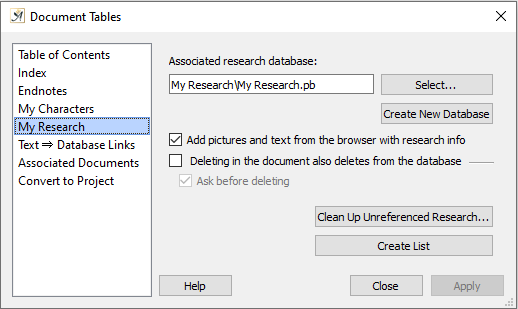
You can associate and create “My Research” databases manually
There is an option to determine whether you would like pictures and text originating from research entries to also be deleted from the database when they are deleted in your document. You can use the button “clean up unreferenced research” to search through your database and delete entries that have not been used. The “create list” button will open the research database and will show only those quotes that have actually been used in your text, so that you can create a report of all quotes in your document.
You can also decide whether you want to add pictures and text from the browser with the attached research information (provided this info is available).
Generating a List of Citations for Your Bibliography
You can generate a list of citations for a bibliography under “Document” → “Indices and Directories” → “Path to ‘My Research’.”
Clicking on the button “Create List” will open the “My Research” database linked to your text.
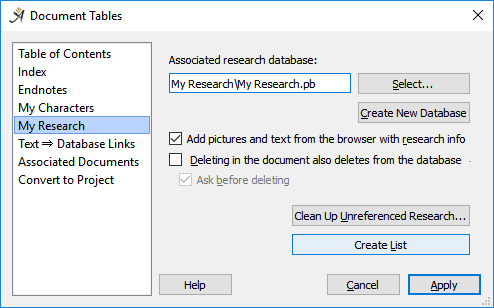
Creating a List of Citations
The table you see will only contain the data entries that have been used as a citation in the text. Data that does not appear in the text at all or that is only found in the Navigator (a source) will not show up on the list.
This database list contains the citations in the order they appear in your main text.
If you want your bibliography to be sorted alphabetically, you can do this by clicking on the author field.
You can then style and execute a report to generate a bibliography.
The Interaction of Papyrus Author and Internet Browsers (Papyrus Research Add-On)
Dragging and dropping ![]() from some internet browsers works (how well it works depends on the browser), but you won’t necessarily get all the data you can find on an internet page.
from some internet browsers works (how well it works depends on the browser), but you won’t necessarily get all the data you can find on an internet page.
The only browser that will retrieve most (but not all) of this information for you “by itself” (without an add-on) is Safari. And this only happens when you drag and drop with your mouse. If you copy from Safari and paste into Papyrus Author, most of the data won’t be transferred.
For most browsers, the normal drag and drop with the mouse ![]() or the copy and paste method simply doesn’t work well enough. Thus, a Papyrus Author add-on was created for our recommended browsers “Google Chrome” and “Mozilla Firefox”.
or the copy and paste method simply doesn’t work well enough. Thus, a Papyrus Author add-on was created for our recommended browsers “Google Chrome” and “Mozilla Firefox”.
Papyrus Author can create a better and more functional connection to your browser than by simply copying and pasting or dragging and dropping alone.

This button will open the site in your browser, which you can then add as a bookmark/favorite
First you save the page as a bookmark (or a “favorite” depending on what your browser calls it.)
Then you can mark the information you wish to save–text or picture. When you click on the “Papyrus Research” bookmark your data will be sent to Papyrus Author–with all the necessary information (the page of the citation, the title of the page, etc.)
For those interested: this page contains JavaScript code to allows you to take research from any website you like and drag it to Papyrus Author with your mouse ![]() . Papyrus is recognized as a “localhost” server and receives data through the channel 7000. So, instead of using the button you can also click on the following link: http://localhost:7000.
. Papyrus is recognized as a “localhost” server and receives data through the channel 7000. So, instead of using the button you can also click on the following link: http://localhost:7000.
Deleting Research for a Document
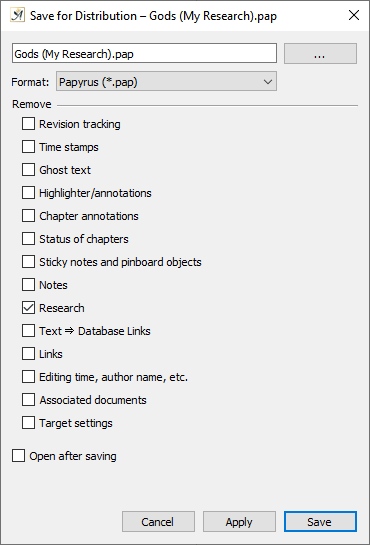
You can export your document with or without research and many other elements in it
You may want to free your text of certain research “leftovers” still hanging around in your document or you have a document with research attached and want to send it to someone without sending your research.
To free your document of unwanted research go to the menu “File” and “Publish” then click on “Save for Distribution.” Generate a new Papyrus Author document (ideally with a new name) and click on Remove – “Research.” This will remove the “My Research” database and any research in the Navigator, which ensures that your new document can be saved and sent without any unwanted research attached.
If you would like to completely turn off research for all future texts, you can do this in “Preferences” under “Research” by deselecting “ ![]() Pictures and text from browser with research info.”
Pictures and text from browser with research info.”
